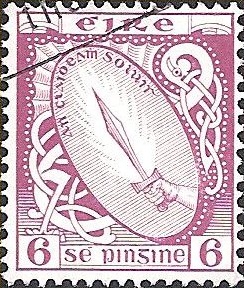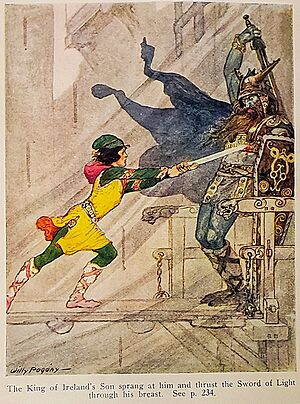Claíomh Solais facts for kids
The Sword of Light is a famous magical sword that appears in many old stories from Ireland and Scotland. In Irish, it's called Claidheamh Soluis (pronounced "KLEE-uv SOL-ish"). This sword is often a very important item that heroes must find on their exciting adventures.
Sometimes, the Sword of Light is part of a story where a hero is looking for "The One Story." This special story is about a man who was magically turned into a wolf by his wife. The sword itself isn't part of the wolf story, but it's a big part of the hero's journey to find it.
In other tales, the Sword of Light is part of a "bridal quest." This is where a hero tries to win a beautiful wife. The hero might gamble with a powerful wizard, called a gruagach, and lose. This means the hero has to go on a very difficult quest to find the sword. Luckily, helpful animals often join the hero to assist them on their journey.
Some experts believe the Sword of Light is like the powerful, god-slaying weapons from ancient Irish myths. These include the lightning weapon of an old Celtic god, the sling of the god Lugh that defeated the giant Balor, the hero Cúchulainn's magical spear called Gae bulga, and his shining sword Cruaidín Catutchenn.
Contents
What's in a Name?
The name of the sword has been spelled in different ways over time. In older Irish texts, you might see it as Claidheamh Soluis or (an) cloidheamh solais. Today, in modern Irish, it's spelled Claíomh Solais. In English, it's usually called the "Sword of Light" or sometimes the "Shining Sword."
In Scottish Gaelic, a similar language, it's called claidheamh solais, which means "glaive of light." Sometimes it's even called claidheamh geal solais, meaning "White Glaive of Light."
About the Stories
The folk tales that feature the Sword of Light are often about heroes going on quests. These quests can be to win a bride, and sometimes the hero's future bride even helps them on their adventure!
Often, the hero makes a bet with a wizard or druid and loses. This forces the hero to promise they won't go home until they find the Sword of Light and complete other tasks. The person guarding the sword is usually a giant or a powerful old woman (a cailleach), or even a sibling of the wizard.
To get the sword, the hero often has to defeat its keeper. This can be very tricky because the keeper might have a secret weakness. The Sword of Light might be the only weapon that can hurt them. But even then, the enemy might have a special weak spot, like a hidden "external soul" that is kept safe far away, sometimes inside other animals! For example, in the story of "The Young King Of Easaidh Ruadh", the enemy's soul is hidden inside many animals, one inside the other.
Many stories about the Sword of Light also involve the hero finding "The One Story." This is a tale about a wife who was not loyal to her husband and magically turned him into a wolf.
In some of these adventures, the hero has to complete three difficult tasks. They get help from friends, who might be the person they want to marry, helpful animals, or even magical beings like a "little green man" or "little red man."
Famous Tales
The Sword of Light appears in many exciting stories from Ireland and Scotland. Here are some of them:
Irish Folktales
- "The Story of the Sculloge's son from Muskerry"
- "Adventure of the Sgolog and the Red Gruagach"
- "The Weaver's Son and the Giant of the White Hill"
- "The Thirteenth Son of the King of Erin"
- "Ashypet" or "The Lazy Fellow"
- "Smallhead and the King's Sons"
- "Morraha"
- "Simon and Margaret"
- "Beauty of the World"
- "The King who had Twelve Sons"
- "Cud, Cad, and Micad"
- "Coldfeet and Queen of Lonesome Island"
- "Art and Balor Beimenach"
- "The Shining Sword and the Knowledge of the Cause of the One Story about Women"
- "The King of Ireland's Son" (In some versions of this story, the hero finds "the sword of the three edges" instead of the Sword of Light.)
- "The Snow, Crow, and the Blood"
Scottish Gaelic Folktales
- "The Young King Of Easaidh Ruadh"
- "Widow's Son"
- "Tale of Conal Crovi"
- "Tale of Connal"
- "Maol a' Chliobain"
- "The Widow and her Daughters"
- "Mac Iain Dìreach"
- "An Sionnach, the Fox"
- "The Herding of Cruachan"
- "The History of Kitty Ill-Pretts"
See also
- Lugh's spear - Another famous weapon from Irish mythology.
- Lúin of Celtchar - A powerful spear from Irish legends.
- Four Treasures of the Tuatha Dé Danann - Other magical items from Irish myths.
- Nuada Airgetlám - An Irish god with a silver arm.



